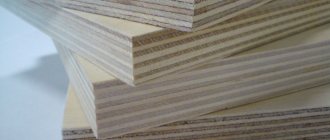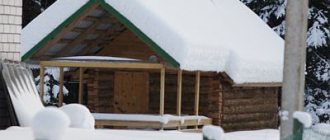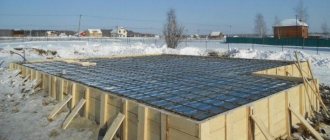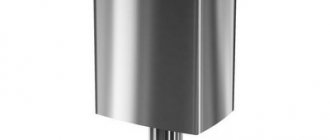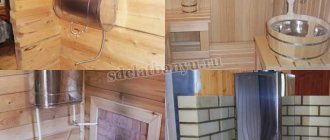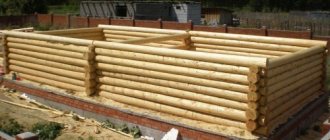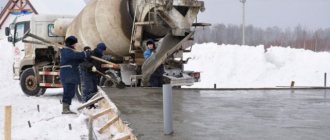Building a house in which a large family will gather to celebrate holidays and joyful events together is the dream of any man. As a rule, every owner who wants to build his own house has many questions that he wants to figure out on his own, without turning to the help of specialists. This will amuse your vanity and save you a lot of money. However, most men are stopped by the same problem - deciding what time of year to build a house. Previously, it was believed that this was only possible in the summer, but scientific progress makes it possible to build housing in the winter. The only caveat is that you should find out in advance at what temperature concrete work can be carried out.
Features of winter concreting
There are two important reasons that complicate the process of laying concrete in winter.
- At low temperatures, the process of cement hydration slows down, which causes an increase in the time it takes for concrete to harden. The full strength gain of concrete when using an antifreeze additive occurs after 90 days at a design concrete discharge temperature of 0 °C, according to recommendations for the use of antifreeze additives in concrete.
Increase in strength of concrete with antifreeze additive:
| Estimated concrete curing temperature according to C | Concrete strength % of design. When hardening in frost over a period of time, days | |||
| 7 | 14 | 28 | 90 | |
| 0 | 35 | 50 | 75 | 100 |
| -5 | 25 | 35 | 60 | 90 |
| -10 | 15 | 25 | 45 | 70 |
| -15 | 5 | 15 | 35 | 50 |
| -25 | 20 | 30 | 50 | 60 |
At sub-zero temperatures below -15°C to -25°C, concrete mix hardening accelerators are used along with anti-frost additives. This complex of introduced additives allows the exothermic reaction of cement, additives and water to release a greater amount of heat, significantly accelerate the hydration of cement (i.e. use the maximum amount of water for the reaction and maintain the temperature due to the heat generated during the reaction), which improves the set of initial strength of concrete at negative temperatures. At an ambient temperature of 20°C, within a week the concrete gains about 70% of its design strength. When the temperature drops to 5°C, it will take 3-4 times longer to gain this level of strength.
- Another undesirable process is the development of internal pressure forces that arise due to the expansion of frozen water. This phenomenon leads to softening of concrete. In addition, frozen water forms ice films around the aggregates, disrupting the bond between the components of the mixture. Therefore, it is strictly prohibited to add water to the concrete mixture at the construction site, especially during cold periods, because The mobility of the concrete mixture is regulated by plasticizing chemicals. additives to maintain the water-cement ratio in the concrete mixture.
When water freezes, significant pressure develops in the pores of the hardening mixture, which leads to the destruction of the structure of fragile concrete and a decrease in its strength characteristics.
The decrease in strength is more significant the earlier the age of concrete when water freezes. The most dangerous period is the setting period of the concrete mixture. If the mixture freezes immediately after laying it in the formwork, then its strength at subzero temperatures will be due only to freezing forces. As the temperature rises, the process of cement hydration will resume, but the strength of such concrete will be significantly inferior to that of a material that has not been frozen.
Only concrete that has already gained a certain strength value can withstand freezing without structural damage. It is important to follow the rule of continuous concrete placement to avoid cold joints.
In modern construction in world practice, the most common method of winter concreting is when the concrete mixture is protected from freezing while it sets and gains a certain strength value, which is called critical. The critical value of concrete strength is taken to be strength that is equal to 50% of the brand value. In critical structures, concrete is protected from freezing until it reaches 70% of its design strength.
In modern construction, several methods of concreting in winter are used:
- use of antifreeze additives;
- covering the concrete mixture with PVC film and other insulation materials;
- electric and infrared heating of concrete;
- construction of a temporary shelter with heating by heat guns.
If heating with heat guns is used, then the PVC film shelter is not laid on the concrete surface, but on a temporary frame made of boards, bars, etc. Something like a low “tent” or “tent” is created over a concrete structure and heat guns are placed under this shelter. The higher the temperature under the tent, the faster the process of gaining strength will proceed, and accordingly, the earlier it will be possible to stop warming up. In most cases, 1-3 days of heating with heat guns is enough for the initial strength of concrete to be sufficient for further work. During this time, concrete can gain up to 50% of its brand strength.
The influence of temperature on concrete hardening
Concrete is a mixture of fillers - sand and crushed stone, bonded together with hardened cement laitance. When it reacts with water, it hydrates, then it hardens with the simultaneous evaporation of water. Critical strength at normal temperatures is achieved within one or one and a half days, depending on the humidity of the surrounding air.
The optimal temperature for the reaction to occur is about 20⁰C; the solution gains design strength within 28 days. To prevent water from evaporating too quickly in the first days, the concrete is covered with waterproofing.
At 5⁰C, the solidification of the composition slows down by 2 times, and at zero temperature, hydration stops. If the critical strength of concrete has been reached before this, nothing will happen to it; it will gain strength after warming. If critical strength has not been gained before freezing, the material will not gain the required indicators and will crumble after defrosting. In this case, it is impossible to pour any brand of concrete at sub-zero temperatures.
Applications of antifreeze additives
Technologically, the most convenient and cost-effective method of winter concreting is the use of anti-frost additives.
This method is much cheaper than concreting with heating by electricity and infrared rays. There are quite a lot of myths regarding the harmfulness and usefulness of certain antifreeze additives for concrete. They are credited with corrosion of reinforcement, a decrease in strength, and a decrease in frost resistance. This is wrong. Many of the antifreeze additives, on the contrary, are corrosion inhibitors and have a positive effect on the adhesion of reinforcement to concrete. With normal % introduction of additives into concrete, there is a slight lag in the rate of strength gain, but upon reaching 28 days of age, a greater increase in grade strength is often observed in concrete with antifreeze additives.
Antifreeze action modifiers can be used either independently or in combination with various heating methods.
All existing “winter” additives to concrete can be divided into three main groups.
- The first group includes additives that either slightly accelerate or slightly slow down the processes of setting and hardening of the mixture. Representatives of this class are strong and weak electrolytes, non-electrolytes and compounds of organic origin - urea and polyhydric alcohols.
- The second group includes modifiers based on calcium chloride. These substances have the ability to greatly accelerate the setting and hardening processes and have significant antifreeze properties.
- The third group includes substances that have weak antifreeze properties, but are strong accelerators of setting and hardening with strong heat release immediately after pouring. The scope of application of these additives is small, but they are of interest from a scientific point of view. These additives include trivalent sulfates based on aluminum and iron.
Features of pouring concrete under different weather conditions
Pouring concrete in hot weather
Pouring concrete in scorching heat will be a real challenge for those who like to procrastinate.
The real test will be pouring concrete in scorching heat.
The floor hardens quickly, so you must adhere to certain rules:
- mandatory use of waterproofing. Even if it is not required due to weather conditions, its presence will not allow moisture to seep into the soil;
- a larger number of employees will increase the speed of work and ensure high-quality surface coverage;
- finishing the slab in two ways - with an aluminum float and a steel object - will provide a high-quality coating;
- to get a little extra time to complete the job, you should use a wetter mixture;
- You should start moistening the slab immediately after the treated surface has hardened.
Work in the cool season
When working in frosty weather, concrete hardens slowly. Once the slab is laid, you need to wait at least an hour before starting to grout by hand.
Due to the fact that performing this stage requires greater speed than the same actions on a hot day, you need to follow some tips:
- Do not moisten the concrete more than necessary;
- if weather conditions do not require the use of polyethylene waterproofing, it is worth allowing moisture to escape into the ground. This will speed up the hardening of the concrete;
- you should fill the area with the mixture as early as possible, this will ensure faster readiness for work, since during the day the air temperature is higher, and accordingly, the mixture hardens faster.
Concrete hardens slowly when working in frosty weather
Pouring concrete in cold weather
Pouring concrete at subzero temperatures requires the creation of special conditions. The solution should not freeze, otherwise the finely sanded surface of the slab will become mushy.
To ensure the best possible coverage when working in cold weather, there are a few things you need to remember:
- You should ask your supplier to mix the solution with warm water on days when the temperature is below freezing. This helps to avoid problems when transporting the mixture;
- the addition of quicklime to the mixture accelerates the initial hardening of concrete and will more firmly resist destructive factors during thawing or freezing. The amount of lime is usually 0.5 - 2% by weight of the mixture;
- It is important to remember that using a large amount of mixture is just as problematic as working in hot weather. The addition of lime makes the composition aggressive towards steel; this component cannot be used when working with concrete reinforced with steel structures;
- you should make sure that the crushed stone cushion is not frozen;
- it is necessary to provide additional heating to the building in which the work is being carried out;
- cover the finished slab with polyethylene and cover it with a layer of hay or straw more than 100 mm thick to provide thermal insulation.
Measures that increase the effectiveness of the use of antifreeze additives
Antifreeze additives play an important role - they activate the hardening processes of the mixture and reduce the freezing point of the liquid phase. But to obtain an effective result, along with the use of modifiers, it is necessary to carry out a number of related activities.
- The creation of internal heat in a concrete mixture is facilitated by preheating its components.
- After laying is completed, the concrete surface must be insulated with mats, which will retain the heat generated as a result of the exothermic reaction of cement and water and maintain conditions suitable for hardening.
- In winter, it is most effective to use Portland cements and high-quality quick-hardening cements.
When producing a concrete mixture from heated components, a different order of loading all elements is used than in traditional summer conditions, when all dry components are simultaneously loaded into a mixer drum filled with water.
In winter, to avoid cement brewing, water is first poured into the drum, then coarse aggregate is poured, and then the drum is turned several revolutions and sand and cement are poured. The duration of mixing the components in winter should be increased by approximately one and a half times.
- Places for loading and unloading concrete mixtures must be insulated from the effects of wind, and the means of supplying the mixture must be thoroughly insulated.
- The formwork and reinforcement must be cleared of snow and ice, the reinforcement must be heated to a positive temperature.
- A prerequisite for winter concreting is a rapid pace of concreting to minimize heat loss in the concrete mixture, since hydration of the cement in the mixture occurs forty minutes after mixing.
Advantages and disadvantages of winter work
Concreting at subzero temperatures has its advantages and disadvantages, which should not be forgotten.
Concreting at subzero temperatures has its advantages
Advantages:
- Possibility of pouring concrete on loose soil. In the warm season, the soil crumbles, which makes it difficult to properly lay the coating.
- Lower cost of work. The winter period is traditionally considered unsuitable for construction, so many stores offer discounts on materials needed to build a house.
- Expedited provision of services. Unpleasant weather literally forces employees to work faster, which significantly reduces time costs.
Flaws:
- When choosing workers, you should consider craftsmen who are capable of pouring concrete in winter. This is due to the fact that most construction workers only work in the summer.
- There is a high risk that the concrete mixture will freeze, and construction work will have to be suspended until the external temperature reaches positive values.
- In winter, daylight hours are shorter than in summer, so you will need to buy equipment for additional lighting. As a rule, this requires considerable expenditure.
- Pouring a foundation on frozen ground risks subsidence and the appearance of cracks, since the ground sags as it freezes.
Thermos method
Technologically, the “thermos” method is carried out by laying a positive temperature mixture into insulated formwork.
Concrete gains strength due to its initial heat content and exothermic release during the cement hydration reaction. Maximum heat release is provided by Portland cements and high-quality cements. The “thermos” method in combination with antifreeze additives is especially effective.
Concreting using the “hot thermos” method involves briefly heating the mixture to 60-80°C, compacting it while hot and keeping it in a “thermos” or using additional heating. At a construction site, the concrete mixture is heated using electrodes. The mixture acts as a resistance in an alternating current circuit. Electrical heating is carried out in dump truck bodies or tubs.
Concreting technology in winter conditions
As part of the work project, activities are developed that ensure:
- Preventing concrete mortar from freezing during transportation, laying and compaction.
- Prevention of freezing of freshly laid concrete until critical strength is achieved.
- Favorable heat and humidity conditions for strengthening of hardening concrete.
Preparation of concrete in winter. Measures to prevent freezing of ready-mixed concrete during transportation, placement and compaction
The finished concrete mixture supplied to the construction site must have a temperature of at least 5°C. To do this, mixing is carried out in warm (up to 70°C) water, and the filling materials are heated.
Important!
The cement is not heated to avoid welding. The transportation time of the finished concrete solution should not exceed 4 hours.
Surfaces for concreting and reinforcement must be heated close to the temperature of the concrete solution, for which warm or hot air is used, but not steam or water.
When transporting the finished concrete mixture for a long time and it is impossible to use heating, antifreeze additives are used.
Measures to prevent freezing of concrete before reaching critical strength
There are two main methods of winter concreting:
- warm concrete;
- cold concrete.
Cold concrete is concrete that will harden without heating. To ensure its hardening, special antifreeze additives are designed to reduce the freezing point of water and at the same time accelerate hydration reactions so that the amount of unbound water in the solution decreases as quickly as possible.
Widespread antifreeze additives are electrolytes, Na and K salts, but their use has some limitations:
- sodium salts are not used in reinforced concrete, as they lead to corrosion of the reinforcement;
- some types of Portland cement (for example, highly alkaline or made from clinker with a high content of aluminosilicates) are not used in conjunction with electrolytes;
- sodium and potassium salts are not used in mixtures with potentially reactive rock filler;
- electrolyte salts should be tested experimentally for the formation of efflorescence.
Modern complex antifreeze additives do not have the disadvantages of electrolyte salts, provide the ability to carry out concrete work at low temperatures and have a complex effect (not only antifreeze, but also plasticizing and others).
Warm concrete is concrete that, after laying, is subjected to various heating and heating procedures.
Methods for heating concrete
After the concrete is laid and compacted, it is necessary to maintain an optimal temperature until critical strength is achieved, for which three types of measures are used:
- thermos method;
- construction of greenhouses;
- heating the concrete.
These measures are used both independently and in combination with antifreeze additives.
The choice of method depends on many factors:
- type of construction;
- composition of the concrete mixture;
- presence and type of fittings;
- presence or absence of appropriate equipment;
- economic expediency.
Heat conservation or "thermos method"
The thermos method is used in massive structures alone or in combination with accelerator additives. Accelerators contribute to faster hardening of concrete, which means that critical strength will be gained faster.
The hydration reaction is exothermic, that is, it occurs with the release of heat.
In massive structures, enough heat is released for heating, therefore, if you pour concrete into insulated formwork, and after pouring, cover it with PVC film and heat-insulating materials (mats, rolled materials, boards, foam), the concrete will maintain a temperature suitable for hardening up to a critical temperature strength.
Advantages of the method:
- energy saving;
- using concrete's own heat;
- relative simplicity.
Disadvantages of the thermos method:
- use only in massive structures;
- ineffectiveness at particularly low temperatures (solved by adding antifreeze additives);
- not suitable for designs with a large cooling surface area.
Hot dry thermos method
In this case, it is possible to lay concrete on a frozen base without heating. A layer of expanded clay heated to a temperature of 200–300°C is poured into the insulated formwork, and after it cools to 100°C, concrete mixed with warm water is laid. As a result, the heat from the cooling expanded clay is used to heat the concrete.
Construction of greenhouses
Teplyaks are a kind of tents that are installed above monolithic structures. Heat guns are installed inside the greenhouses in such a quantity as to ensure the required hardening temperature (above 5°C). The tightness of the shelter is of particular importance.
Methods for artificial heating of concrete
The highest rate of concrete hardening is at a temperature of 50°C.
It is possible to ensure the design temperature of concrete hardening until critical strength is achieved by using artificial heating of concrete using various methods:
- Electrode. Electrodes are fixed inside the formwork, which can be plate, strip, rod, or string. Heat is generated when current is passed through the concrete mixture.
- Conductive (contact). Heat is generated in the conductor when current passes through it and is transferred to the concrete mixture.
- Infrared. IR radiation is used to warm up the base, reinforcement and heat concrete without a heat carrier.
- Induction. Heat is generated by the fittings located in the electromagnetic field of the inductor.
The disadvantage of the methods is the need to use expensive equipment and electricity.
The use of anti-frost and accelerating additives allows concrete to quickly gain critical strength and thus save energy and increase equipment turnover.
Methods of artificial heating and heating of concrete
The essence of this method is to create and further maintain the temperature of the mixture at the maximum permissible value until the concrete gains the required strength.
This method is used in cases where the “thermos” method is not enough. There are several options to achieve the desired result:
- Electrode
The physical meaning of electrode heating is similar to the above-described method of electrode heating of the mixture. In this case, the heat that is released by the mixture when an electric current is passed through it is used. To conduct electric current to concrete, several types of electrodes are used: plate, string, strip, rod. The most effective are plate electrodes made from roofing steel. The plates are sewn onto the surface of the formwork, which is in direct contact with the concrete, and connected to opposite phases of the network. Current exchange occurs between opposing electrodes, resulting in heating of the entire concrete structure.
- Conductive (contact)
The essence of contact or conductive heating is the use of heat generated in a conductor during the passage of electric current through it. By contact method, heat is transferred to all surfaces of the concrete element. From the surfaces, heat spreads throughout the structure. For contact heating of concrete, thermoactive flexible coatings or thermoactive formwork are used.
- Infrared The
infrared heating method is based on the ability of infrared rays, when absorbed by the body, to be transformed into thermal energy. Heat from the emitter to the heated body is carried out instantly without the use of a heat carrier. Quartz and tubular metal emitters are used as infrared wave generators. Infrared heating is used to warm reinforcement, frozen concrete surfaces, and thermal protection of laid concrete mixture.
- Induction
Induction heating uses the heat that is released in steel formwork or reinforcement parts and products located in the electromagnetic field of an inductor coil. This method is used to warm up previously made concrete structures at any ambient temperature and in any formwork.
To speed up the process of stripping and further loading the structure during the cold period, it is advisable to use a concrete class that is an order of magnitude higher to quickly gain normalized strength.
Compliance with the recommendations for winter concreting will help avoid loss of strength characteristics of concrete and reinforced concrete structures made at low outside temperatures.
What conditions are considered “winter” when concreting and masonry work?
Before you understand what features and limitations entail negative temperatures during “wet” processes, you need to understand what is meant by winter concreting conditions.
Many people believe that winter conditions are conditions in which the outside temperatures are consistently below freezing and it is snowing. Actually this is not true. In accordance with SP 70.13330.2012 “Load-bearing and enclosing structures”, winter conditions are when the average daily outside air temperature is below +5 °C, or the minimum daily temperature is below 0 °C .
That is, as you can see, the concept of “winter” conditions covers a wide range of temperatures. They can occur, depending on the region of residence, both in autumn and early spring, and without precipitation in the form of snow.
There is also a widespread belief among novice developers that at subzero temperatures, and even more so if the thermometer drops below -15...-25 °C, it is impossible to pour a foundation or lay wall cladding. Although, if you look at commercial construction, work on the construction of monolithic high-rise buildings and residential apartment buildings is carried out all year round, regardless of weather conditions.
This is due to the use of special concreting techniques and the use of special anti-frost additives - chemicals that modify the concrete mixture.
Rules for winter concrete pouring
The solution is poured into the prepared formwork. Preparation consists of removing ice and snow, heating the reinforcement and the bottom of the foundation. This is the most difficult stage. Scraping off the ice is not so bad, but warming up the reinforcement and the entire perimeter of the foundation is a problem. The temperature should not be high, but it is necessary to achieve positive values.
As an option, you can consider installing portable braziers, which are lowered into a pit and lit there. It is possible to use heat guns powered by gas cylinders. The use of other means is difficult due to their high cost.
Before pouring warm mortar, it is necessary to heat the base and reinforcement to positive temperatures
For this reason, concreting slab foundations in winter is problematic: such areas cannot be heated. For this type of base, “winter” will be limited to light frosts at night and positive daytime temperatures. Pouring can begin after the reinforcement and bottom have a positive temperature.
A strip foundation can also be poured in frosty conditions: it is possible to heat such a foundation and reinforcement to a limited extent. Not easy, but possible.
Everything can be organized in stages. Break the entire tape into small sections, start heating simultaneously or with a certain time interval on several of them (two or three, depending on the time required for kneading and heating the pit). Start pouring one area, moving the fryers further. While the first heated section is being poured, the next one will reach the required temperature. The flooded area is immediately covered with heat-insulating materials and moved on to the next one, moving along the entire perimeter.
It is imperative to knock off the ice and heat the reinforcement - this is the only way the foundation will be strong
The mechanism is clear. So you can pour the foundation with concrete at -15oC (but with appropriate additives, “hot” mixing and measures to preserve heat).
Another important condition is that the work must be carried out continuously. In winter, it is impossible to fill the foundation in parts. This is 100% true. The interval between fills should be such that a film does not have time to form on the surface of the previous part, and even more so that the moisture does not freeze. Work must be carried out continuously until the filling is completed. Filled parts must be immediately covered with heat-insulating mats. As you can see, this job requires several people. One person cannot cope with all tasks.
Work must be carried out continuously
Please note that the maximum solution temperature should be 35-40oC. Its excess leads to a slowdown in the rejection processes. The situation will, of course, be better than when it freezes, but not by much.
Winter concrete at home
During home construction, concreting in conditions of negative temperatures is acceptable for objects of low importance.
For independent work, use kneading in heated (not higher than 70°C) water.
The order of laying the components of the concrete mixture is changed: first, coarse aggregate is poured into the water, then sand and cement.
Advice: In winter, it is recommended to use Portland cement of at least M400 grade.
At home, the use of heating concrete or installing greenhouses is not profitable; special anti-frost additives come to the fore, which make it possible to successfully carry out concrete work in winter.
Is it possible to add salt and modifying additives to concrete?
In winter, to lower the freezing point of free water, salt (sodium chloride) or other sodium and potassium salts, which act as electrolytes, are added to the concrete solution.
The use of salts can lead to corrosion of reinforcement and the appearance of efflorescence on finished concrete. The best option is to use complex antifreeze additives and plasticizers.
Physical processes and governing provisions
The concept of “winter conditions” in the technology of monolithic concrete and reinforced concrete is somewhat different from the generally accepted one - calendar.
Winter conditions begin when the average daily outside air temperature drops to +5°C, and during the day there is a drop in temperature below 0°C. At subzero temperatures, water that has not reacted with cement turns into ice and does not enter into a chemical combination with cement. As a result, the hydration reaction stops and, therefore, the concrete does not harden. At the same time, significant internal pressure forces develop in the concrete caused by an increase (by about 9%) in the volume of water as it turns into ice. When concrete freezes early, its fragile structure cannot withstand these forces and is damaged. During subsequent thawing, frozen water again turns into liquid and the process of cement hydration resumes, but the destroyed structural bonds in concrete are not completely restored.
Freezing of freshly laid concrete is also accompanied by the formation of ice films around the reinforcement and aggregate grains, which, due to the influx of water from less cooled areas of the concrete, increase in volume and squeeze the cement paste away from the reinforcement and aggregate.
All these processes significantly reduce the strength of concrete and its adhesion to reinforcement, and also reduce its density, resistance and durability.
If concrete acquires a certain initial strength before freezing, then all the processes mentioned above do not have an adverse effect on it. The minimum strength at which freezing is not dangerous for concrete is called critical.
The value of the standardized critical strength depends on the class of concrete, the type and operating conditions of the structure and is: for concrete and reinforced concrete structures with non-prestressing reinforcement - 50% of the design strength for B7.5...B10, 40% for B12.5...B25 and 30% for B 30 and above, for structures with prestressing reinforcement - 80% of the design strength, for structures subject to alternating freezing and thawing or located in the zone of seasonal thawing of permafrost soils - 70% of the design strength, for structures loaded with a design load - 100% of the design strength.
The duration of concrete curing and its final properties largely depend on the temperature conditions in which the concrete is exposed. As the temperature rises, the activity of water contained in the concrete mixture increases, the process of its interaction with the minerals of the cement clinker accelerates, and the processes of formation of the coagulation and crystalline structure of concrete intensify. When the temperature decreases, on the contrary, all these processes are inhibited and the hardening of concrete slows down.
Therefore, when concreting in winter conditions, it is necessary to create and maintain such temperature and humidity conditions under which the concrete hardens until it acquires either critical or specified strength in the shortest possible time with the least labor costs. For this purpose, special methods of preparing, feeding, laying and curing concrete are used.
When preparing a concrete mixture in winter conditions, its temperature is increased to 35...40C by heating the aggregates and water. The fillers are heated to 60C with steam registers, in rotating drums, in installations with flue gases blown through the filler layer, and with hot water. Water is heated in boilers or hot water boilers to 90C. Heating cement is prohibited.
When preparing a heated concrete mixture, a different procedure is used for loading the components into the concrete mixer. In summer conditions, all dry components are loaded simultaneously into the mixer drum, pre-filled with water. In winter, in order to avoid “brewing” of cement, water is first poured into the mixer drum and coarse aggregate is loaded, and then, after several revolutions of the drum, sand and cement are added. The total duration of mixing in winter conditions is increased by 1.2 ... 1.5 times. The concrete mixture is transported in closed, insulated and heated containers (tubs, car bodies) before starting work. Cars have a double bottom, into the cavity of which exhaust gases from the engine enter, which prevents heat loss. The concrete mixture should be transported from the place of preparation to the place of placement as quickly as possible and without overload. Loading and unloading areas must be protected from the wind, and the means of supplying the concrete mixture to the structure (trunks, vibrating trunks, etc.) must be insulated.
The condition of the base on which the concrete mixture is laid, as well as the laying method, must exclude the possibility of freezing at the junction with the base and deformation of the base when laying concrete on heaving pounds. To do this, the base is heated to positive temperatures and protected from freezing until the newly laid concrete acquires the required strength.
Before concreting, formwork and reinforcement are cleared of snow and ice, reinforcement with a diameter of more than 25 mm, as well as reinforcement made of rigid rolled profiles and large metal embedded parts are heated to a positive temperature at temperatures below - 10 ° C.
Concreting should be carried out continuously and at a high rate, and the previously laid layer of concrete should be covered before its temperature drops below the specified level.
The construction industry has an extensive arsenal of effective and economical methods for curing concrete in winter conditions, which ensure high quality structures. These methods can be divided into three groups: a method involving the use of the initial heat content introduced into the concrete mixture during its preparation or before laying it in a structure, and the heat release of cement accompanying the hardening of concrete - the so-called “thermos” method; methods based on artificial heating of concrete , laid in the structure - electric heating, contact, induction and infrared heating, convective heating, methods using the effect of lowering the eutectic point of water in concrete using special anti-freeze chemical additives.
These methods can be combined. The choice of one method or another depends on the type and massiveness of the structure, the type, composition and required strength of concrete, meteorological conditions of the work, energy equipment of the construction site, etc.
